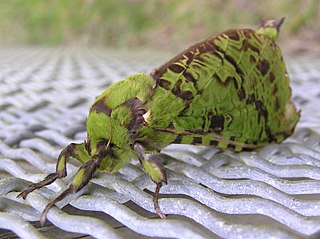Barca or Barce may refer to:

Abantiades is a genus of moths of the family Hepialidae. There are 14 described species, all found exclusively in Australia. The group includes some large species with a wingspan of up to 160 mm. The larvae feed on the roots of Eucalyptus and other trees.

Aenetus is a genus of moths of the family Hepialidae. There are 24 described species found in Indonesia, New Guinea, New Caledonia, Australia and New Zealand. Most species have green or blue forewings and reddish hindwings, but some are predominantly brown or white. The larvae feed in the trunks of living trees, burrowing horizontally into the trunk, then vertically down.

Abantiades magnificus is a moth of the family Hepialidae. It is found in southern New South Wales and eastern Victoria.

Abantiades latipennis, known as the Pindi moth, is a species of moth in the family Hepialidae. It may also be referred to as a swift moth or a ghost moth, as this is a common name associated with Hepialidae. Endemic to Australia and identified in 1932, it is most populous in temperate rainforest where eucalypti are prevalent, as the larvae feed primarily on the roots of these trees. Females lay eggs during flight in a scattering fashion. The larvae live for over eighteen months underground, while adult moths survive for approximately one week, as they have no mouthparts with which to feed. The moths are preyed upon by a number of predators, including bats and owls. Brown in colour overall, males are paler and the identifying silver bars of the male's wings are more prominent than those of the female's, with dark margins. Male adults are generally smaller.

Abantiades barcas is a moth of the family Hepialidae. It is endemic to the Australian Capital Territory, New South Wales and Queensland.
Abantiades albofasciatus is a moth of the family Hepialidae. It is endemic to Western Australia.
Abantiades aphenges is a moth of the family Hepialidae. It is endemic to Australia, including New South Wales and Queensland.
Abantiades aurilegulus is a moth of the family Hepialidae. It is endemic to Western Australia.
Abantiades fulvomarginatus is a moth of the family Hepialidae. It is endemic to Western Australia.

Abantiades hydrographus is a moth of the family Hepialidae. It is endemic to Western Australia.
Abantiades labyrinthicus is a moth of the family Hepialidae. It is endemic to Australia, where it is found in the Australian Capital Territory, New South Wales, Queensland, Tasmania and Victoria.

Abantiades leucochiton is a moth of the family Hepialidae. It is endemic to Australia, where it is found in New South Wales, South Australia and Victoria.
Abantiades ocellatus is a moth of the family Hepialidae. It is endemic to Western Australia.
Abantiades sericatus is a moth of the family Hepialidae. It is endemic to Western Australia.

Caliadurgus is a genus of spider wasps of the subfamily Pepsinae. These are medium-sized black spider wasps with some red. They have a catholic habitat choice and their preferred prey are spiders of the families Araneidae and Tetragnathidae. They have a Holarctic and Neotropical distribution.

Hylaeus hyalinatus, the hyaline spatulate-masked bee, is a species of hymenopteran in the family Colletidae. It is found in North America.












